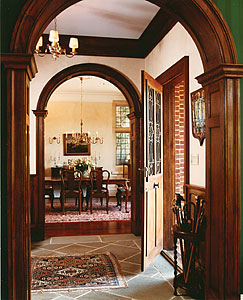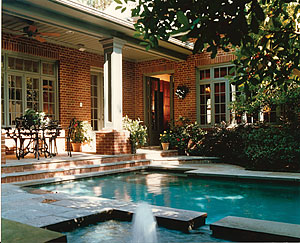Living in English heritage
www.stonexp.com
2010-11-06 11:13:23
Popularity Index:0
Source:Internet
Meanwhile, at the kitchen/dining area, a raised fireplace utilizes Leuders limestone in several formats. “We have cut Leuders stone on the hearth, and the face of it is a chopped Leuders stone,” Chambers said. “We used rough-back pieces, which show the minerals [and evidence of] the quarrying process, and the homeowners decided it was appropriate to the design.” Additionally, the kitchen countertops were done in a rust-colored granite that blends with the overall aesthetic of the space. Natural stone can also be found at the entry foyer, where Pennsylvania Bluestone was specified. “We had a cut pattern with a border around the outside and a diagonal on the inside,” he said. “The front door was brought in from England, and [the homeowner] kept telling me the thickness of the door. It was very thin, and I wasn’t sure how it would work in terms of the hardware, but everything came out great. Sometimes your clients have incredible ideas and imagination. It was wonderful working with them and all these antique pieces.”
The same Pennsylvania Bluestone was used at the pool area, and in addition to its design value, the stone provided practical benefits as well. “There are some stones that are a little less money, but we have enough cold weather down here that we can have a severe winter,” Chambers said. “We know we won’t have a problem with freeze/thaw cycles with Bluestone. It is also rustic and attractive. It is similar to some of the stones you see on surfaces in Europe. We noticed a lot of them in Italy, where they are doing new paving patterns to match older patterns that have worn down.”
In addition to stone that was cut specifically for the residence, the homeowners also selected antique slate roofing from England. “There is a little bit of it over the bay windows, and then the roof was done in the slate,” Chambers said. “It was brought to the U.S. in containers. That was another example of stone being used again, and having a long-lasting value. We do new slate roofs, and we consider them to be 100-year roofs, but this was older than that. One detail that we wanted was a parapet wall at the end of each gable of the slate roof, with a limestone cap. From the standpoint of the brick, we did an English Garden Wall bond pattern on the brick, which has some of the bricks turned. The masons did a great job.”
Speaking on some of the challenges in completing the project, the architect said that utilizing traditional building processes and techniques was something that required an extra level of communication. “We were trying to create something that had an Old World look to it, but to do it like it was done originally,” he said. “So often, people try to imitate the look of something historical. But when trying to build these bay windows, for example, a lot of contractors forget that you can build out of solid masonry.” |






